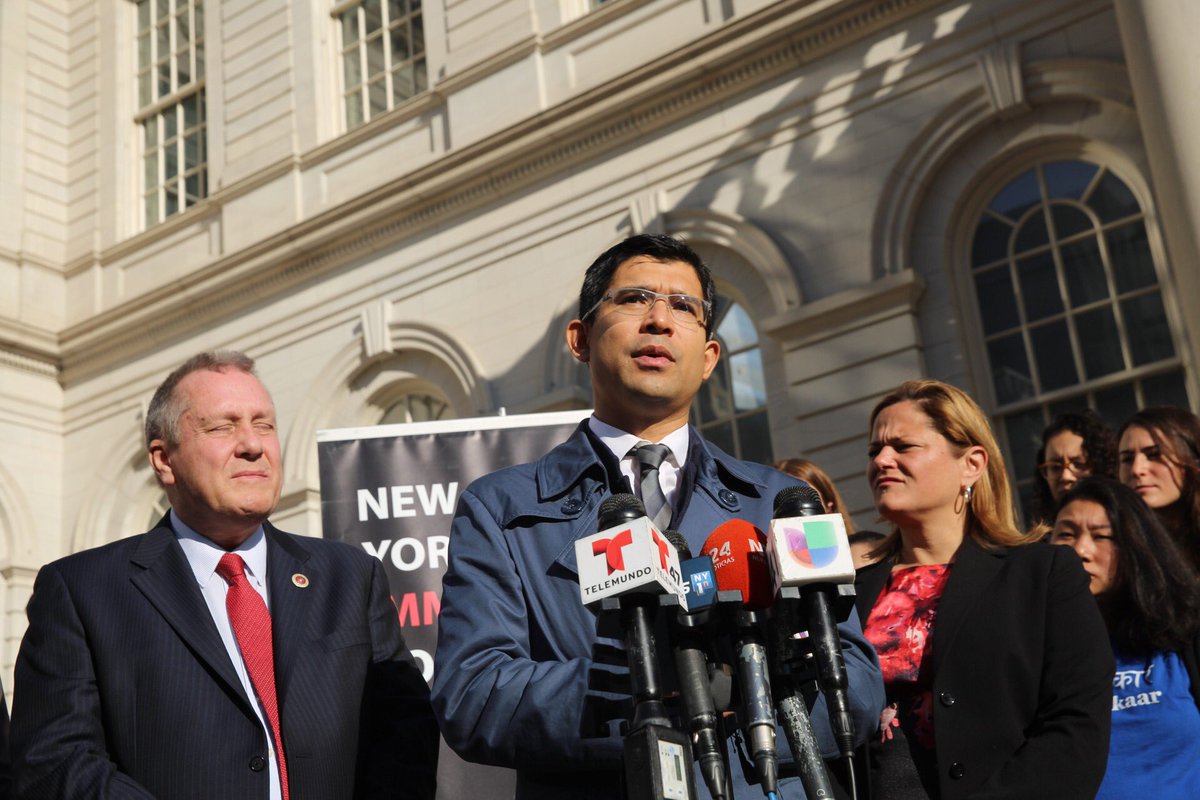How Obama Can Help New York Immigrants Before Leaving Office

City Council Member Carlos Menchaca, the author (photo: William Alatriste)
Barack Obama may have given his farewell address, but he still has work to do. In his speech, the president rightly celebrated America’s history of welcoming immigrants and their contributions to our country. But Mr. Obama’s legacy on immigration is mixed. He has both deported more people than any prior president and acted in America’s best traditions by letting the Dreamers - undocumented youth brought to the United States as children – emerge from the shadows. There is one final step that President Obama can, and should, take to cement his legacy on the side of history we know is in his heart.
Most immigrant families in the United States are mixed status, meaning most have children who are citizens and immigrant parents, including Legal Permanent Residents (LPRs). The incoming administration’s promise to deport 2-3 million people with legal infractions threatens to rip these American families apart, because the threshold for deporting legal permanent residents is so low. Experts argue that this 2-3 million number cannot be reached without deporting people for minor offenses, such as traffic tickets. This is why I recently joined 60 local elected officials from across the country in asking President Obama to grant a blanket pardon to legal immigrants who have minor infractions and pose no threat to the country. He can prevent the breakup of these American families.
Pardoning this group of immigrants fits with the president’s recent actions on criminal justice and immigration. His clemency initiative and Deferred Arrival for Childhood Arrivals (DACA) program seek to fix the broken criminal justice and immigrant systems that harm American families.
Having already designated Legal Permanent Residents with minor convictions as low priorities for deportation, President Obama could protect these American families further with a presidential pardon.
Some will object, arguing that America is a country of law and order. We agree, and support the deportation of those posing a risk to our community. We also support the American belief that punishment should fit the crime. Someone who had a minor infraction such as shoplifting or excessive traffic violations as a teenager could be eligible for deportation 20 years later as a responsible adult with children who are citizens. These deportations make no sense, and hurt families and children without enhancing the wellbeing of the country.
The group making this request, Local Progress, is composed of local elected officials that know, work with, live in, represent, and are part immigrant communities. We know that deportations cripple families and harm neighborhoods and the economy. We also know that the American Dream lives in our communities and that the country benefits from these newcomers and their children. Pardoning this group would prevent the unnecessary breakup of our American families, and allow parents to stay where they belong, raising their children in the communities they have helped build.
Watching President Obama’s farewell speech, I could not help but think about the many families in my Brooklyn district that have lost a family member to deportation. The effects are harsh. When a father gets deported, the family loses income and can lose their apartment. The education of children can be disrupted, and those remaining long to be with their missing family member. For the children – citizens, immigrants, or both – it is a hurt that does not go away. It is a step the U.S. government should not take lightly, or for symbolic political reasons.
I stand with my fellow elected officials to ask President Obama to grant these pardons. I also call on my fellow New Yorkers to call the president’s office and tell him to grant clemency to the hundreds of thousands of immigrants who stand to lose under President Trump. Before he leaves office, President Obama can help cement his legacy with such a pardon. He has the power, and should use it, as other presidents have done in the past. There is still time.
***
Carlos Menchaca is a New York City Council Member and Chair of the Council’s Immigration Committee. On Twitter @cmenchaca.
***
Have an op-ed idea or submission for Gotham Gazette? Email This email address is being protected from spambots. You need JavaScript enabled to view it.
Tackling New York’s Unfinished Infrastructure Business

Bridge construction (photo: Gov. Cuomo's office)
As legislators return to Albany for the 2017 session, bolstering the state’s infrastructure clearly ranks high on their “to-do” list. While Governor Cuomo and the Legislature made vital investments last session with passage of the $27.1 billion transportation multi-year capital plan, there was also unfinished business which must be addressed this year to ensure those dollars will deliver the cost-effective results taxpayers expect.
Despite bipartisan legislation allowing some New York City agencies to use design-build contracts, it was surprisingly left languishing in committee last session. City Department of Transportation Commissioner Polly Trottenberg says gaining design-build authority is a top legislative priority. “I still have to use traditional design-bid-build, which, frankly, will add years to the project and tens of millions, if not hundreds of millions, of dollars. It just makes no sense,” Trottenberg recently said.
Design-build would be the single most effective step to update aging infrastructure and build new schools and public housing. Yet, despite bipartisan support, New York City is not allowed to capture the innovative and collaborative efficiencies design-build has delivered elsewhere in the state.
Design-build isn’t new and it’s not radical; however, it does require public owners (like cities, states and the federal government) to provide flexibility in the procurement process, allowing designers and builders to collaborate earlier in the process, creating projects which allocate risks more efficiently and improving delivery time and budget.
Even though New York lags behind many other states in approving design-build authority, the state’s successes are impressive. The emergency reconstruction of State Route 42 in Greene County, after its damage from Hurricane Irene, was completed in just four months, ahead of schedule and approximately 10 percent under budget using design-build. The state Department of Transportation projects the $550 million replacement of the Kosciuszko Bridge will be completed 3.5 years earlier thanks to design-build.
The largest capital project in the state used design-build for the New NY Bridge (replacing the Tappan Zee) which is projected to cost $1.7 billion less than originally planned while delivering 18 months ahead of schedule. And even though the city’s efforts at securing design-build have been futile in recent years, the state, led by Governor Cuomo, has been able to provide project specific authorization for the city. Specifically the billion-dollar expansion of the Jacob J. Javits Center and the Penn Station renovations will use design-build contracts.
Given the many New York design-build successes over just a few years, it’s impossible to understand why the Legislature has not granted all state agencies permanent design-build authority. Instead, we face a seemingly never-ending cycle of budget re-authorizations to allow the design-build delivery method; leaving agencies, contractors, subcontractors, and the workers they employ in a biannual legislative limbo. It’s even worse for New York City leaders who have no design-build authority even though they see the potential to save $2 billion over 10 years.
In these politically divisive days, it’s no small feat to find legislative proposals on which virtually everyone can agree. Design-build should be one of those proposals. Allowing innovation and collaboration to flourish on design-build projects in New York has stretched limited public funds by consistently delivering time and cost benefits on the vital infrastructure projects citizens support. New York is making the investments, now it must deliver the most cost-effective results possible. Providing permanent design-build authority for all New York State agencies while removing barriers for the City of New York is a win-win for lawmakers and the taxpayers they represent.
***
Steven Ruether is Liberty Region President for the Design-Build Institute of America. On Twitter @DBIAnational.
***
Have an op-ed idea or submission for Gotham Gazette? Email This email address is being protected from spambots. You need JavaScript enabled to view it.
City Must Remove Nonprofits from Tax Lien Sale

(photo: Sofie Hecht/Gotham Gazette)
In New York City, tiny, vulnerable, nonprofit organizations too often lose the real estate they own to for-profit developers. These unjustifiable losses are a complete mix-up of city and state tax policy, through the mechanism called the tax lien sale. New York City needs to fix this problem by removing nonprofits from the tax lien sale.
Nonprofits of various sizes -- religious institutions, universities, and community gardens alike -- frequently own property. These organizations, due to their nonprofit status, according to the New York State Constitution and New York State law and are tax exempt. Yet every year, New York City facilitates the sale of some of these properties to private speculative developers, and it is never the mega universities or big churches that end up in this mess, but small, local nonprofits.
New York City is correctly concerned with maintaining its tax base to keep the city functioning. In 1996, the Giuliani administration drastically changed the way the city deals with owners who don’t pay their property taxes out of concern for the lost tax revenue. One aspect of that change was the introduction of the tax lien sale for all property owners, including nonprofit owners even though they do not owe these taxes in the first place.
The tax lien sale works like this: if you, as a property owner, don’t pay your property taxes, the city places a lien on your property and sells it to a tax lien trust, an investment vehicle only rich ("accredited") investors can use. The trust then adds interest and fees and collects the "past due" taxes even when they were not technically due. If the property owner doesn't pay those fees, the trust initiates foreclosure and then sells to a buyer, usually a developer, at a post-foreclosure auction.
If you are a nonprofit owner, to avoid the tax lien sale you need to successfully apply for a tax exemption. When your tiny organization has a staff of two or three people, sometimes the administration is imperfect and you don’t file an exemption form when you acquire the property, which can lead to the loss of your property because of the tax lien system.
To continue avoiding the tax lien sale, your nonprofit needs to annually file a renewal form with the Department of Finance. So, if your community garden board misses a few pieces of mail because the former president retired and the new generation of garden caretakers doesn’t have every city agency sending mail to the right place, the renewal might not get filed. And the tax lien warnings may go unnoticed.
In a year or two, New York City thinks this property has a civic duty to pay taxes (which it does not) and is delinquent in that duty. The lien gets sold, and then your garden or church gets foreclosed. The worst case scenario happens when a developer shows up with court papers at your garden’s fence and tells you “we own this now and you must go.”
So, even though the state constitution provides for the exemption of property taxes for nonprofits, and even though New York law provides that your property is exempt from the date you acquire the property as a nonprofit, the City Department of Finance is still permitting the tax lien sales of nonprofits.
As D.W. Gibson reported earlier this year, the Black Veterans for Social Justice in Bedford-Stuyvesant, Brooklyn learned this year that tax debt on their property had been sold. Tax debt that, under state constitutional principle and state law, they do not owe. They are working on untangling this mess before their building ends up in foreclosure.
Tax revenue from property owners is an important piece of how the city functions. But this cannot be an excuse for seeing a small community nonprofit, especially in an already pressed neighborhood, fall into foreclosure.
The city should collect taxes from luxury real estate developers. The city should exert more muscle to collect fines from delinquent landlords who permit their buildings to collapse around tenants. The city should focus its hunt for lost revenue on the actual organizations that legally and morally should be paying it.
The rules around tax lien sales are up for renewal this year. New York City must exempt nonprofits from the tax lien sale altogether. New York City should not be seeking lost revenue from the most vulnerable populations. This problem can be fixed.
****
Richard Semegram is a tenant lawyer and an advisory committee member of 596 Acres. On Twitter @richagram.
***
Have an op-ed idea or submission for Gotham Gazette? Email This email address is being protected from spambots. You need JavaScript enabled to view it.




